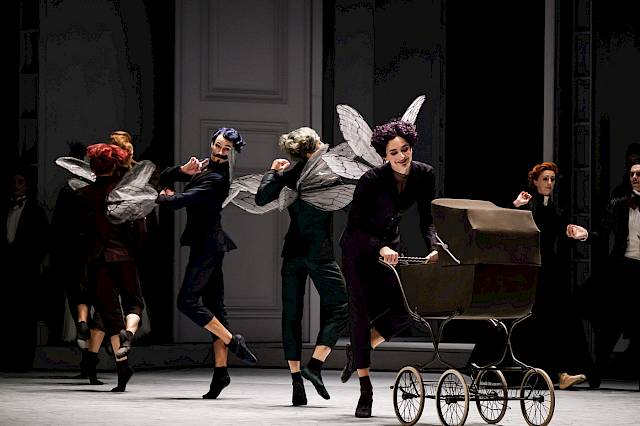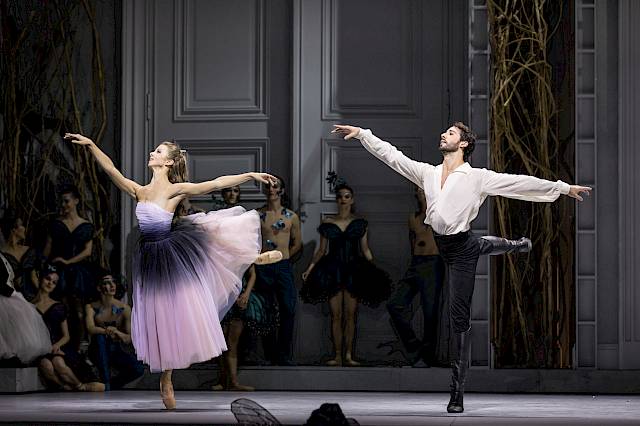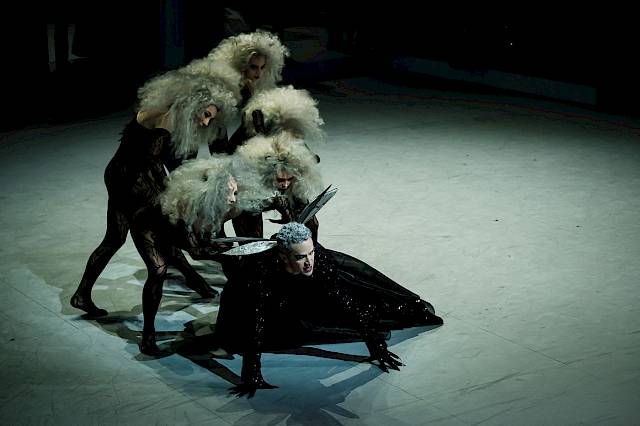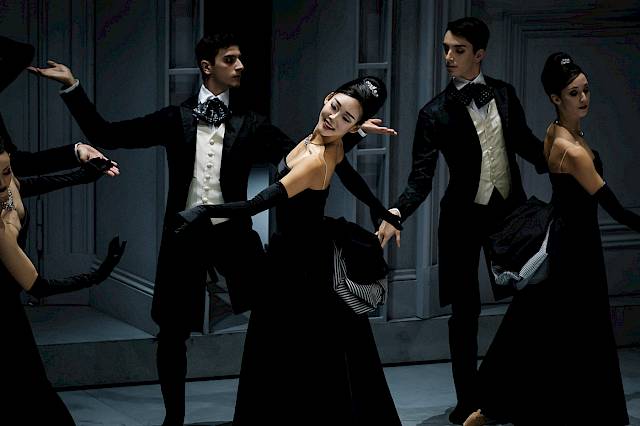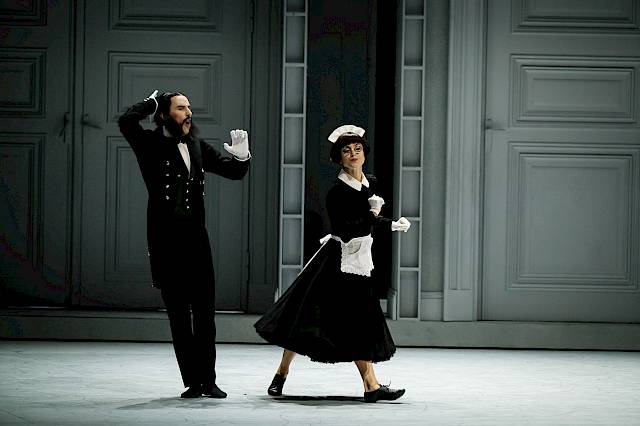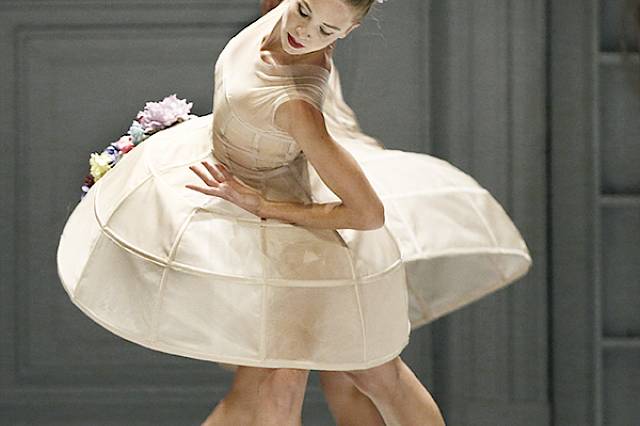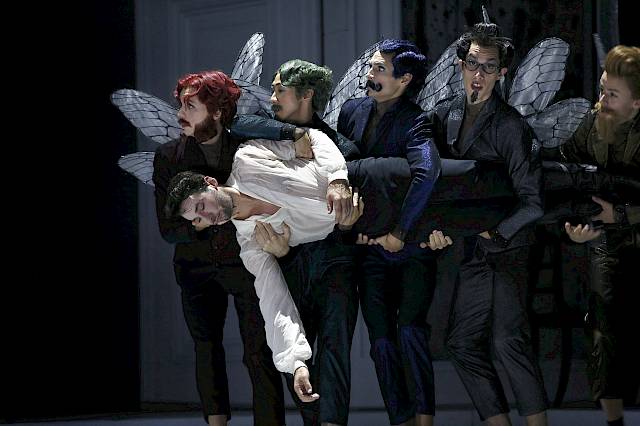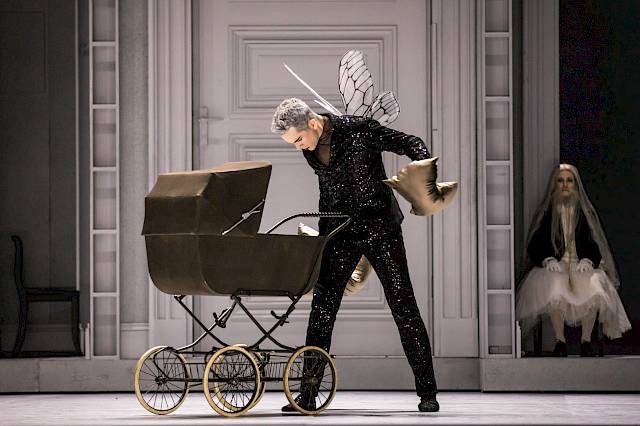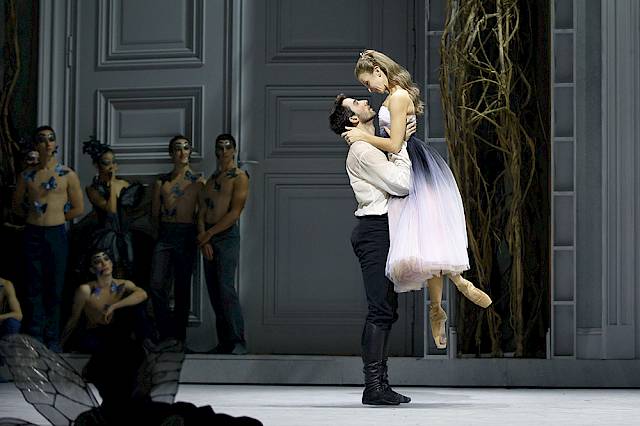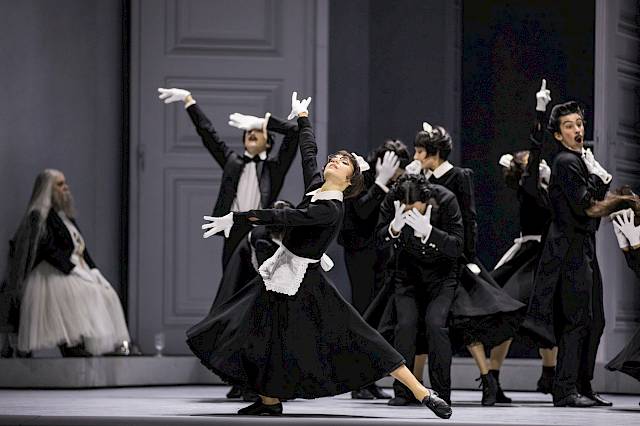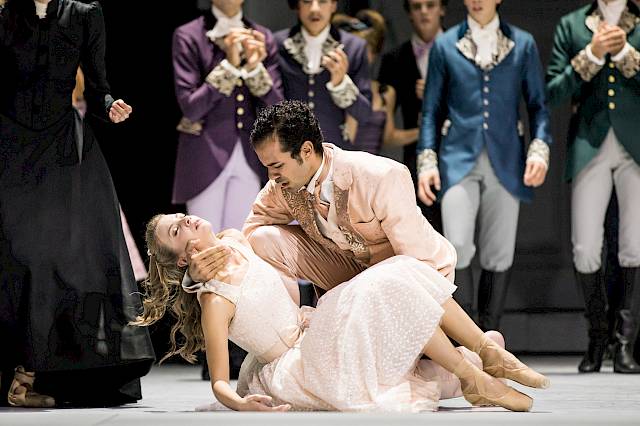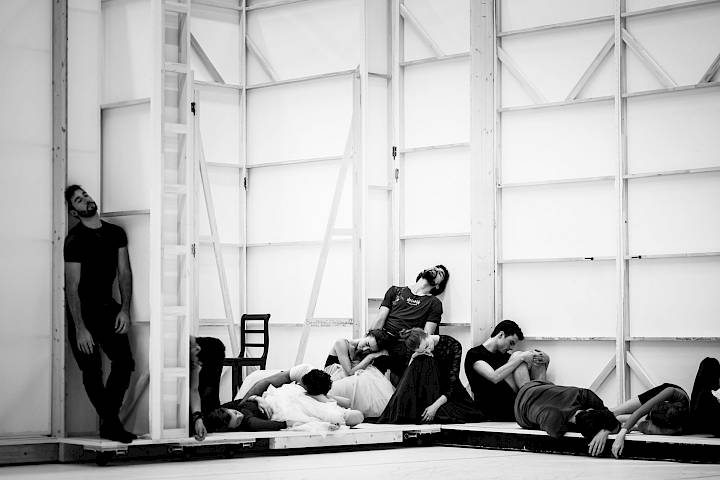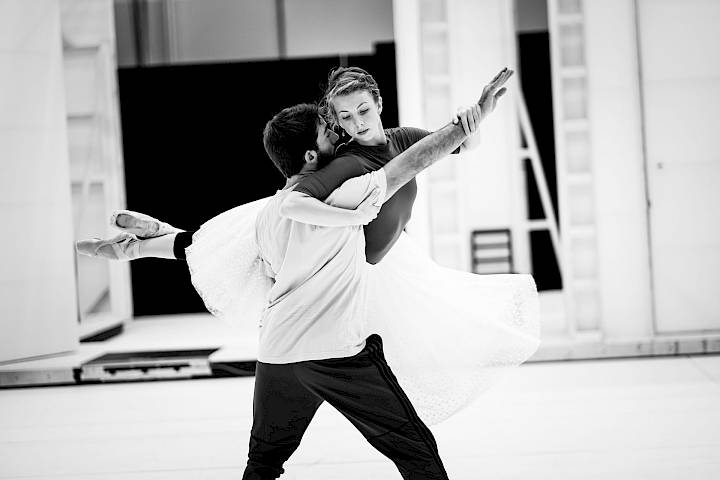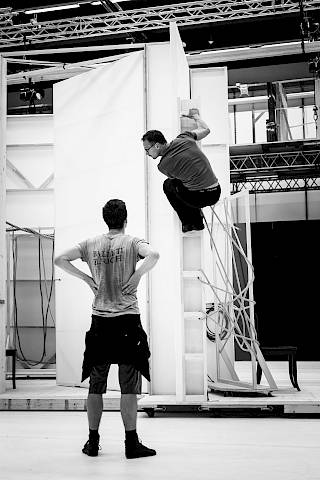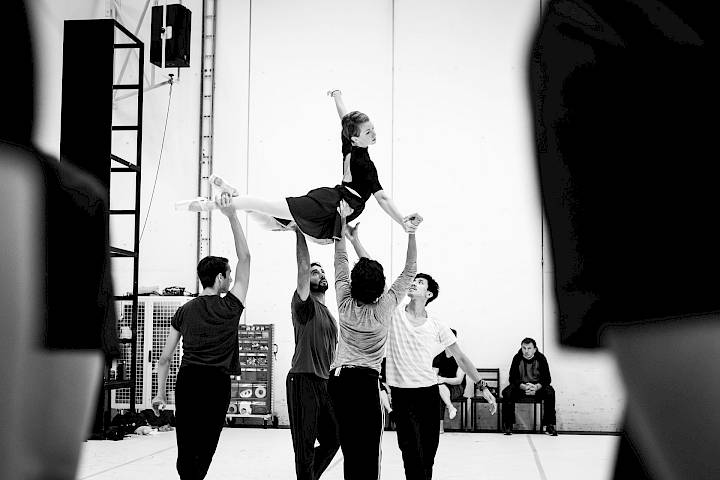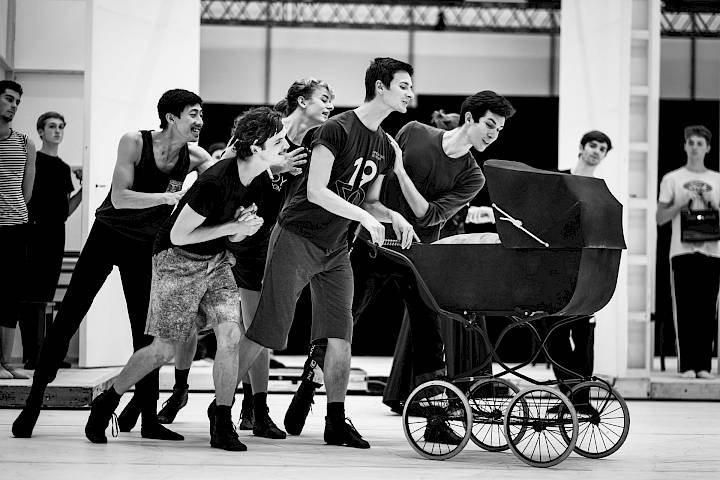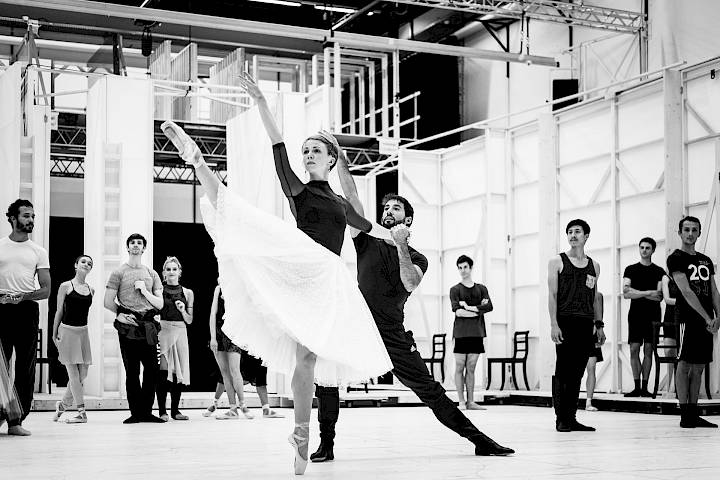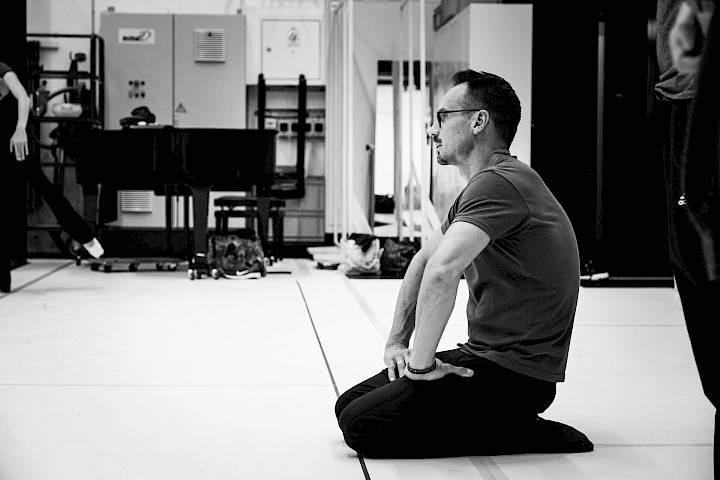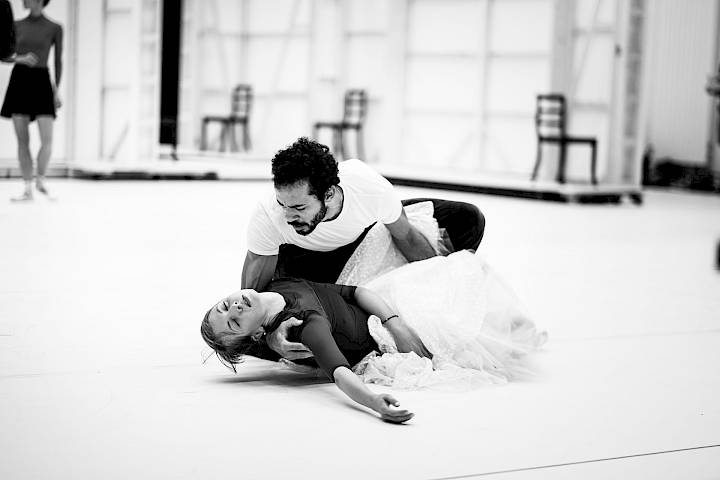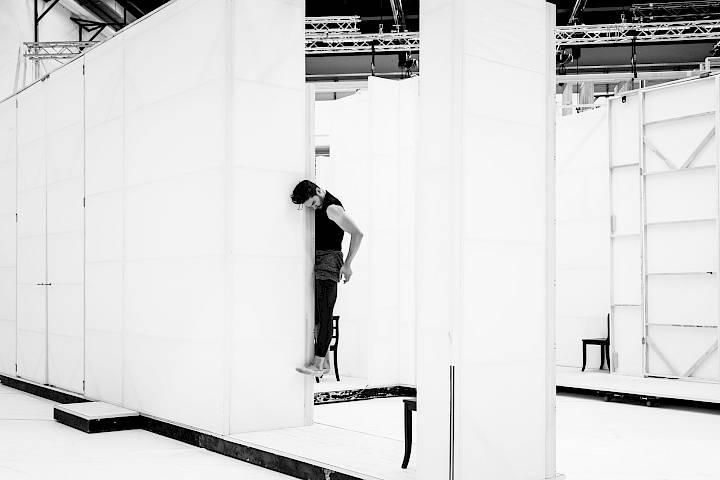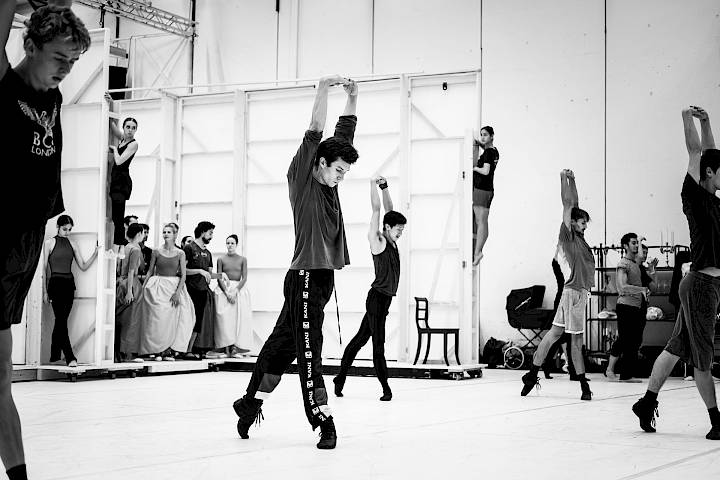Dornröschen
Music by Pyotr I. Tchaikovsky (1840-1893)
Ballet in one prologue and two acts by Christian Spuck
after the fairytale «La Belle au bois dormant» by Charles Perrault
Duration approx. 2 H. 35 Min. incl. intermission after approx. 1 H. 20 Min. Introduction 45 min before the performance.
Past performances
October 2020
10
Oct19.00
Dornröschen
Ballet by Christian Spuck, Choreographic World Premiere, Premiere subscription A
November 2020
December 2020
March 2021
Good to know
Dornröschen
Abstract
Dornröschen
Six fairies were invited to Princess Aurora’s christening, and together, they will in turn gift her all of the good traits she might need. But the evil fairy Carabosse was not invited, and she gets her revenge with a curse: Aurora will prick her finger on the spindle of a spinning wheel and die. The good fairy Fliederfee cannot undo the evil fairy’s curse, but she can weaken it. And when a grown-up Aurora does prick her finger, she and all of the castle’s inhabitants fall into a hundred-year sleep, from which only a prince can awaken her.
Dornröschen premiered at the Mariinsky Theatre in St. Petersburg in 1890. Tchaikovsky wrote the music, and Marius Petipa, one of the most important choreographers of his time, brought it to the stage as a ballet. For the storyline, the successful duo drew from the French version of the fairytale written in the 17th century by Charles Perrault. It differs only slightly from the more-familiar version by the Brothers Grimm.
Following on the success of another great Tchaikovsky ballet – the Nutcracker – Christian Spuck takes an ironic, subtle look at the story of the sleeping beauty. He is particularly interested in the fate of the fairy Carabosse. With his proven team of costume designer Buki Shiff and set designer Rufus Didwiszus, Christian Spuck recreates this famous ballet classic in his own personal artistic style.
Dornröschen
Synopsis
Dornröschen
Prologue
The royal couple’s desire to have children has long gone unfulfilled. Their unanswered prayers have pushed the pair to the extreme. They travel to the realm of the fairies – where babies wait to be brought to their future families – and steal Aurora, a little girl entrusted to the care of the fairy Carabosse.
At the court, the preparations for little Aurora’s christening are in full swing. Everyone – from the host of servants to the governess and the master of ceremonies – has their hands full, readying the castle for the arrival of a multitude of illustrious guests. Among them will be six fairies, who will present the little princess with their good wishes. Just as the glittering celebration is reaching its climax, Carabosse appears. She had, wisely, not been among those invited. She punishes the royal couple for their act by placing a curse on Aurora: in the bloom of her youth, the princess will prick herself on a spinning wheel and die. The other fairies try to drive Carabosse away from the celebration.
Interlude
Carabosse has never recovered from the loss of little Aurora and is distraught over her furious outburst at the baptism. Even more of a burden, though, is the guilt she feels for having burdened Aurora with the irreversible curse; she had meant to place it upon the royal couple.
Act I
Princess Aurora is celebrating her 16th birthday. Many guests are there, including four princes. But none of them can seem to win Aurora’s affection. The king expresses his desire to protect Aurora from disappointment, and to keep all painful experiences away from her. Now he, too, tries to comfort her.
Amid the wild frenzy of the party, Aurora notices a strange woman, who hands a spindle to the girl. Carabosse fails to intervene and snatch the ominous gift from the princess. In an instant, Aurora pricks herself on the spindle, and appears to be lost for all time. The king angrily accuses Carabosse; deeply humiliated and distressed that Aurora is the innocent victim of her curse, Carabosse leaves.
The lilac fairy appears and alters the deadly curse: she places Aurora and everyone else present in a deep sleep. The spell can only be broken when Aurora is awakened by true love’s kiss.
Act II
A long time has passed. Out on a journey, Prince Désiré and his betrothed, accompanied by a large entourage, come upon an enchanted castle, overgrown with thorn bushes. The prince feels especially drawn to the magical power of the castle. Once he is alone, the lilac fairy appears to him. She shows him a vision of Princess Aurora, and he is captivated. He must find her!
In search of the woman he saw in his vision, he happens upon Carabosse and her entourage. Thinking only of Aurora, Carabosse wants to find out if Désiré’s heart really beats for the princess.
The other fairies find the motionless prince a short time later. The lilac fairy revives him, so that he in turn can awaken Aurora with his kiss. But to the horror of the prince and the fairies, his kiss fails to rouse the princess! Carabosse, too, is distraught – she has seemingly lost Aurora forever. Tenderly, she kisses the sleeping beauty’s forehead in farewell – and Aurora opens her eyes. With that kiss of true love, Carabosse returns the princess to life. Aurora’s eyes fall on Désiré, and it is love at first sight.
The slumbering court is also awakened. In disbelief, Aurora realizes that, as a “fairy child,” she possess magical powers – and can free herself from everything that constrains her and determine her own path in life. She makes everyone fall asleep again, including her parents. Then, with a kiss, she awakens the prince, to whom her heart now belongs.
Biographies
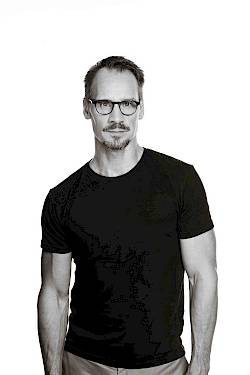
Christian Spuck,
Christian Spuck
Christian Spuck stammt aus Marburg und wurde an der John Cranko Schule in Stuttgart ausgebildet. Seine tänzerische Laufbahn begann er in Jan Lauwers’ Needcompany und Anne Teresa de Keersmaekers Ensemble «Rosas». 1995 wurde er Mitglied des Stuttgarter Balletts und war von 2001 bis 2012 Hauschoreograf der Compagnie. In Stuttgart kreierte er fünfzehn Uraufführungen, darunter die Handlungsballette Lulu. Eine Monstretragödie nach Frank Wedekind, Der Sandmann und Das Fräulein von S. nach E.T.A. Hoffmann. Darüber hinaus hat Christian Spuck mit zahlreichen namhaften Ballettcompagnien in Europa und den USA gearbeitet. Für das Königliche Ballett Flandern entstand 2006 The Return of Ulysses, beim Norwegischen Nationalballett Oslo wurde Woyzeck nach Georg Büchner uraufgeführt. Das Ballett Die Kinder beim Aalto Ballett Essen wurde für den «Prix Benois de la Danse» nominiert, das ebenfalls in Essen uraufgeführte Ballett Leonce und Lena nach Georg Büchner wurde von den Grands Ballets Canadiens de Montréal, dem Charlotte Ballet, USA, dem Tschechischen Nationalballett Prag und vom Stuttgarter Ballett übernommen. Die Uraufführung von Poppea//Poppea für Gauthier Dance am Theaterhaus Stuttgart wurde 2010 von der Zeitschrift «Dance Europe» zu den zehn erfolgreichsten Tanzproduktionen weltweit gewählt sowie mit dem deutschen Theaterpreis Der Faust 2011 und dem italienischen «Danza/Danza-Award» ausgezeichnet. Christian Spuck hat auch Opern inszeniert: Auf Glucks Orphée et Euridice an der Staatsoper Stuttgart folgten Verdis Falstaff am Staatstheater Wiesbaden sowie Berlioz’ La Damnation de Faust und Wagners Fliegender Holländer an der Deutschen Oper Berlin. Von 2012 bis 2023 war Christian Spuck Direktor des Balletts Zürich. Hier waren seine Choreografien Romeo und Julia, Leonce und Lena, Woyzeck, Der Sandmann, Messa da Requiem, Nussknacker und Mausekönig, Dornröschen und Monteverdi zu sehen. Das 2014 in Zürich uraufgeführte Ballett Anna Karenina nach Lew Tolstoi wurde in Oslo, am Moskauer Stanislawski-Theater, vom Koreanischen Nationalballett und vom Bayerischen Staatsballett ins Repertoire übernommen. 2018 hatte in Zürich Spucks Ballett Winterreise Premiere, für das er mit dem «Prix Benois de la Danse 2019» ausgezeichnet wurde. 2019 folgte beim Ballett Zürich Helmut Lachenmanns Das Mädchen mit den Schwefelhölzern (Auszeichnung als «Produktion des Jahres und Kompanie des Jahres für das Ballett Zürich durch die Zeitschrift tanz). Für das Moskauer Bolschoitheater kreierte er 2021 sein Ballett Orlando nach Virginia Woolf. Spucks Messa da Requiem wurde nicht nur zum Adelaide Festival nach Australien eingeladen, sondern auch vom Het Nationale Oper & Ballet Amsterdam und vom Finnischen Nationalballett übernommen. Seit Beginn der Saison 2023/24 ist Christian Spuck Intendant des Staatsballetts Berlin.

Robertas Šervenikas,
Robertas Šervenikas
Robertas Šervenikas studierte Dirigieren am Konservatorium in St. Petersburg. Er ist Leiter des Litauischen Kammerorchesters und Erster Gastdirigent des Nationalen Litauischen Sinfonieorchesters. Von 2008 bis 2018 war er Musikdirektor des Litauischen Nationaltheaters für Oper und Ballett. Dort leitete u.a. Aufführungen von Jewgeni Onegin, La traviata, Der fliegende Holländer, Herzog Blaubarts Burg/Der wunderbare Mandarin und Cornet, eine Oper der litauischen Komponistin Onutė Narbutaitė. Beim Evian Festival dirigierte er Konzerte mit der Philharmonie der Nationen und dem Orchestra Sinfonica di Milano Giuseppe Verdi. Mit dem Litauischen Sinfonieorchester brachte er zahlreiche Werke litauischer Komponisten zur Uraufführung und wurde mit dem litauischen Nationalpreis ausgezeichnet. Seit 2008 ist Robertas Šervenikas dem Bayerischen Staatsorchester verbunden und dirigierte dort zahlreiche Aufführungen des Bayerischen Staatsballetts (u.a. Der Sturm von Jörg Mannes, Ballettabend Forever Young, Romeo und Julia von John Cranko bei einem Gastspiel im Oman). Christian Spucks Ballett Anna Karenina dirigierte er nicht nur in München, sondern auch beim Norwegischen Nationalballett in Oslo. Mit Dornröschen debütiert Robertas Šervenikas beim Ballett Zürich.

Rufus Didwiszus,
Rufus Didwiszus
Rufus Didwiszus studierte Bühnen- und Kostümbild in Stuttgart bei Jürgen Rose und arbeitet seither als freier Bühnenbildner in Theater-, Opern- und Tanzproduktionen, u. a. mit Barrie Kosky (La Belle Hélène, Die Perlen der Cleopatra und Anatevka an der Komischen Oper Berlin; La fanciulla del West, Die Gezeichneten und Boris Godunow am Opernhaus Zürich; Orphée aux enfers, Salzburger Festspiele; Fürst Igor, Opéra de Paris; Der Rosenkavalier, Bayerische Staatsoper), Thomas Ostermeier (u. a. Shoppen &Ficken in der Baracke des Deutschen Theaters Berlin mit Einladung zum Berliner Theatertreffen und nach Avignon; Der blaue Vogel am Deutschen Theater, Feuergesicht am Schauspielhaus Hamburg, Der Name bei den Salzburger Festspielen und an der Berliner Schaubühne, The Girl on the Sofa beim Edinburgh International Festival und an der Schaubühne, Vor Sonnenaufgang an den Münchner Kammerspielen), Sasha Waltz, Tom Kühnel, Christian Stückl, Stefan Larsson, Tomas Alfredson und Christian Lollike. Seit 2004 entwirft und inszeniert Rufus Didwiszus mit Joanna Dudley eigene Musik-Theater-Performances, u. a. in den Sophiensaelen, an der Schaubühne und im Radialsystem in Berlin sowie im BOZAR in Brüssel. Mit seiner Band «Friedrichs» war er in Der weisse Wolf am Staatstheater Stuttgart zu sehen. Zudem war er als Gastdozent an der Akademie der Bildenden Künste München und an der Kunsthochschule Berlin-Weissensee tätig. Für Barrie Kosky entstanden zuletzt die Bühnenbilder zu Rimski-Korsakows Der goldene Hahn an der Komischen Oper Berlin, Das Rheingold am Royal Opera House London sowie Offenbachs Les Brigands an der Opéra National de Paris.

Buki Shiff,
Buki Shiff
Buki Shiff wurde in Israel geboren und studierte an der Universität Tel-Aviv. Seit 1984 ist sie als Bühnen- und Kostümbildnerin für Theater, Film, Fernsehen und Oper in Israel, Europa und den USA tätig. Dabei arbeitet sie regelmässig mit den Regisseuren Barrie Kosky, David Alden, Richard Jones und Robert Carsen zusammen. Zu ihren Arbeiten zählen Ausstattungen für Les Contes d’Hoffmann, Faust, Sweeney Todd, Cavalleria Rusticana, Pagliacci, Boris Godunow, Madama Butterfly und Don Giovanni an der New Israeli Opera Tel Aviv, Tannhäuser, L’Incoronazione di Poppea, Rinaldo, Rodelinda, La Calisto, Orlando und Semiramide an der Bayerischen Staatsoper in München, Lohengrin, Die Meistersinger von Nürnberg, Tristan und Isolde und Der fliegende Holländer an der Berliner Staatsoper, Boris Godunow an der Wiener Volksoper, Tristan und Isolde am Teatro Real Madrid, Lulu an der English National Opera, Wozzeck und Meistersinger an der Welsh National Opera, Candide am Théâtre du Châtelet in Paris und an der Mailänder Scala, Wozzeck und La belle Hélène an der Komischen Oper Berlin, Die Nase am Royal Opera House Covent Garden sowie Die Liebe zu den drei Orangen an der Deutschen Oper Berlin. 2006 wurde Buki Shiff in Tel-Aviv als Bühnen- und Kostümbildnerin des Jahres ausgezeichnet, 2008 erhielt sie den Rosenblum-Preis als Künstlerin des Jahres. 2013 wurde sie bei den International Opera Awards in London als beste Bühnen- und Kostümbildnerin geehrt. Darüber hinaus war sie an Kunstausstellungen in Tel Aviv und Europa beteiligt.

Martin Gebhardt,
Martin Gebhardt
Martin Gebhardt war Lichtgestalter und Beleuchtungsmeister bei John Neumeiers Hamburg Ballett. Ab 2002 arbeitete er mit Heinz Spoerli und dem Ballett Zürich zusammen. Ballettproduktionen der beiden Compagnien führten ihn an renommierte Theater in Europa, Asien und Amerika. Am Opernhaus Zürich schuf er das Lichtdesign für Inszenierungen von Jürgen Flimm, David Alden, Jan Philipp Gloger, Grischa Asagaroff, Matthias Hartmann, David Pountney, Moshe Leiser/Patrice Caurier, Damiano Michieletto und Achim Freyer. Bei den Salzburger Festspielen kreierte er die Lichtgestaltung für La bohème und eine Neufassung von Spoerlis Der Tod und das Mädchen. Seit der Spielzeit 2012/13 ist Martin Gebhardt Leiter des Beleuchtungswesens am Opernhaus Zürich. Eine enge Zusammenarbeit verbindet ihn heute mit dem Choreografen Christian Spuck (u.a. Winterreise, Nussknacker und Mausekönig, Messa da Requiem, Anna Karenina, Woyzeck, Der Sandmann, Leonce und Lena, Das Mädchen mit den Schwefelhölzern). Er war ausserdem Lichtdesigner für die Choreografen Edward Clug (u.a. Strings, Le Sacre du printemps und Faust in Zürich), Alexei Ratmansky, Wayne McGregor, Marco Goecke, und Douglas Lee. Mit Christoph Marthaler und Anna Viebrock arbeitete er beim Händel-Abend Sale und Rossinis Il viaggio a Reims in Zürich sowie bei Lulu an der Hamburgischen Staatsoper zusammen und mit Jossi Wieler und Sergio Morabito an der Oper Genf für Les Huguenots. 2023 gestaltete er das Licht für Spucks Ballett Bovary beim Staatsballett Berlin und 2024 Rossinis Tancredi an den Bregenzer Festspielen. Ausserdem war er Lichtdesigner bei Atonement von Cathy Marston am Opernhaus Zürich.

Marta Andreitsiv,
Marta Andreitsiv
Marta Andreitsiv is from Ukraine. She trained at the Kiev Dance Academy and at the Tanz Akademie Zürich. She won the silver medal in the 2016 Tanzolymp Berlin. This is her second season as a member of the Junior Ballett.

Isabelle Bratt,
Isabelle Bratt
Isabelle Bratt is from Canada. She trained at Canada’s National Ballet School and is the recipient of the Peter Dwyer Award. During her time there, she appeared in Jera Wolfe’s Arise and in La Bayadère. She appeared in James Kudelka’s Nussknacker with the National Ballet of Canada. This is her third season as a member of the Junior Ballett.

Greta Calzuola,
Greta Calzuola
Greta Calzuola is Italian. She completed her training at the ballet school of the Umbria Ballet in Italy and at the Académie Princesse Grace in Monte Carlo. She won the International Ballet Competition in Longiano in 2014. This is her second season as a member of the Junior Ballett.

Lauren Draper,
Lauren Draper
Lauren Draper is Canadian. She received her training at Canada’s National Ballet School, at the School of Cadence Ballet, and at the Kirov Academy of Ballet in Washington. She appeared in James Kudelka’s Nussknacker with the National Ballet of Canada. This year is her third as a member of the Junior Ballett.

Désirée Guler,
Désirée Guler
Désirée Guler is Swiss. She received her training at the Tanz Akademie Zürich and won third prize at the European Ballet Grand Prix in Vienna in 2020. She appeared with Ballet Zürich in 2016 in Schwanensee. This is her second season as a member of the Junior Ballett.

Daniela Thorne,
Daniela Thorne
Daniela Thorne is from San Francisco and is a citizen of Brazil and the USA. She was awarded with the Gillian Murphy Scholarship, and studied at the University of North Carolina School of Arts. She continued her training at the Dutch National Ballet Academy in 2018. This is her second season as a member of the Junior Ballett.

Matthew Bates,
Matthew Bates
Matthew Bates was born in Great Britain and studied at the Royal Ballet School in London. There he was the recipient of the Valerie Adams Award. He has appeared as Fritz in Der Nussknacker with the Royal Ballet. This is his third season as a member of the Junior Ballett.

Luca D'Amato,
Luca D'Amato
Luca D’Amato is from Italy and was trained at the Tanz Akademie Zürich. He was the winner of the Spoleto Competition in 2015 and of the Tanzolymp Berlin in 2018. This is his third season as a member of the Junior Ballett.

Achille De Groeve,
Achille De Groeve
Achille de Groeve is Belgian and was trained at the Royal Ballet School in Antwerp. He was a finalist at the «Prix de Lausanne» in 2019. This is his third season as a member of the Junior Ballett.

Grégoire Duchevet,
Grégoire Duchevet
Grégoire Duchevet comes from France. He trained at the École de Danse de l’Opéra de Paris and was a guest student at the Dutch National Ballet Academy during the 2019/20 season. This is his second season as a member of the Junior Ballett.
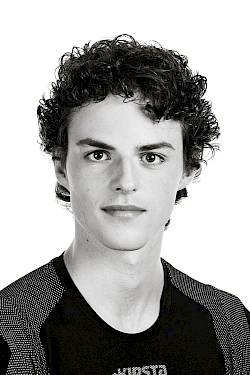
Wolf Hoeyberghs,
Wolf Hoeyberghs
Wolf Hoeyberghs is from Belgium. He received his training at the Royal Ballet School in Antwerp and at the European School of Ballet (ESB) in Amsterdam. He was the winner of the Munich International Ballet Competition in 2017 and a prizewinner at Tanzolymp Berlin. He has performed with the Royal Ballet of Flanders, the Dutch National Ballet, and Ballett Zürich. This is his third season as a member of the Junior Ballett.

Théo Just,
Théo Just
Théo Just is French. He studied at the Conservatoire National Supérieur de Danse de Paris and at the Tanz Akademie Zürich. He was a prizewinner at the Youth America Grand Prix in 2015 and at the Spoleto Competition in 2018. He was a member of the Polish National Ballet in Warsaw during the 2018/19 season, where he appeared in choreographies by Krzysztof Pastor, Liam Scarlett, Wayne Eagling, and John Neumeier. Additionally, he presented his own choreography entitled Me to Me, by Us. This is his third season as a member of the Junior Ballett.

Lukas Simonetto,
Lukas Simonetto
Lukas Simonetto holds Swiss, French, and Czech citizenship. He trained at the Association pour la Formation de jeunes Danseurs (AFJD) in Lausanne as well as at the Tanz Akademie Zürich. He won the «Prix d’études de danse» of the MIGROS Kulturprozent in 2018 and 2019. This is his second season as a member of the Junior Ballett.

George Susman,
George Susman
George Susman is from Australia and was trained at the Tanz Akademie Zürich. He was a prizewinner at the Tanzolymp Berlin in 2018 and won the gold medal at the European Ballet Grand Prix in Vienna. This is his third season as a member of the Junior Ballett.

Martina Renau,
Martina Renau
Martina Renau comes from Spain. She trained at the Conservatorio Valencia. She was a member of the NRW Junior Ballett Dortmund from 2018 to 2020 and appeared in numerous Ballett Dortmund performances. This is her second season as a member of the Junior Ballett.




